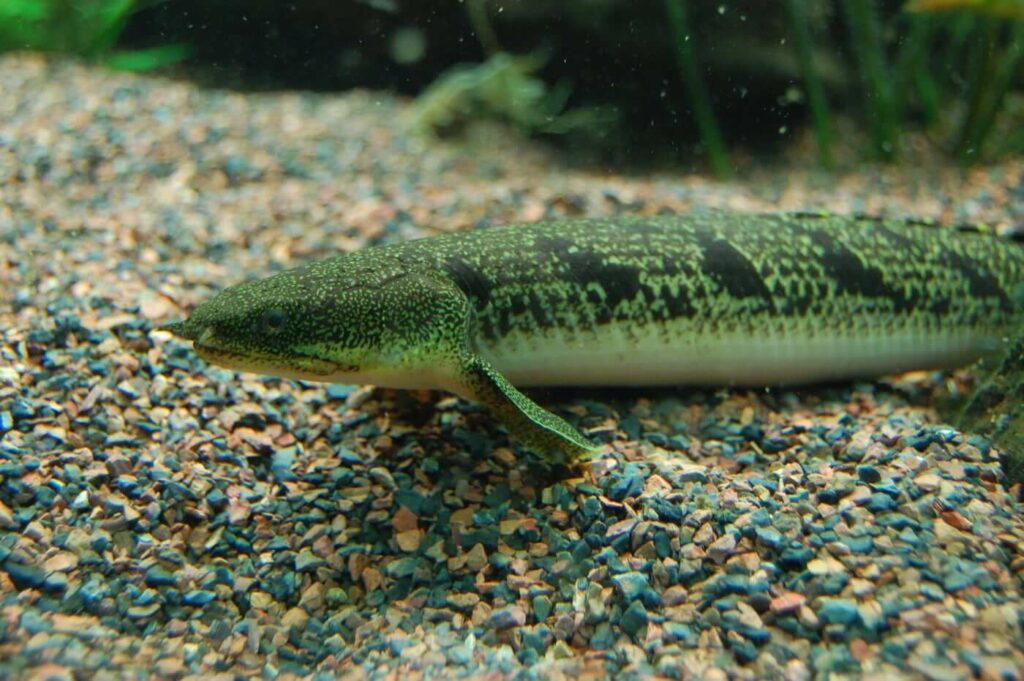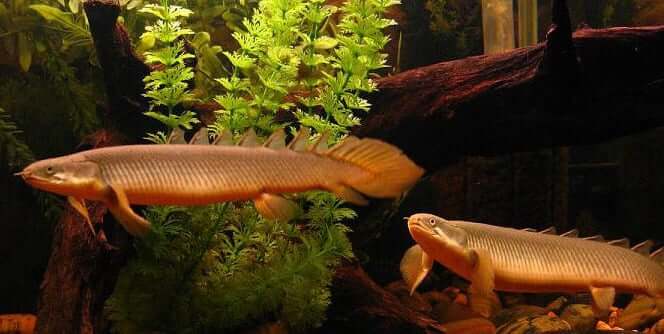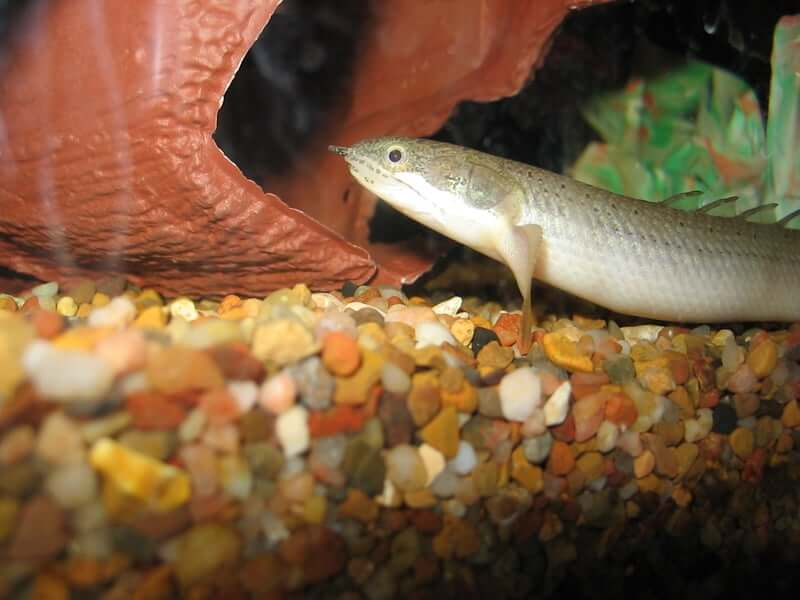The bichir is an awesome and unique freshwater fish that adds a very prehistoric feel to your tank.
In fact, they’re one of our favorite freshwater fishes you can get. Period.
There are also a few different types you can get that all have different colors and patterns. You have a lot of options!
But if you’re interested in getting one of these ancient-looking fish, you’ll need to know how to keep them happy and healthy. That’s where this guide comes in.
Below, you’ll learn everything you need to know about bichir care and this fish in general. Tank size, diet, tank mates, and more. It’s all here!
Table of Contents
Species Summary
Bichirs (Polypterus bichir) are a tropical freshwater fish that have been around for a VERY long time. They make up the Polypteridae family and are mostly found in Northeast Africa throughout the Nile River and its associated tributaries.
Bichirs prefer shallow, swampy waters and can thrive in semi-brackish waters as well. Their build makes them suitable for this kind of habitat which is partially why they have remained unchanged for such a long period of time.
Because of the murky waters where they come from these fish have very poor eyesight. There simply isn’t enough visibility for good vision to be useful!

Instead, bichirs use their other senses to navigate and find food. They have a good sense of smell and also are able to sense electricity in the water. They have ampullae of Lorenzini which are little organs that can pick up the electricity of other animals in the water. As you can imagine, this is quite useful!
Bichirs are an interesting fish because they have a pair of lungs and need access to the surface to get oxygen. One of the main reasons for this is the waters where they come from are usually so swampy and dirty that it makes breathing a challenge. This design solves all that.
Bichir lungs are a bit different than the lungs of other fish such as dwarf gourami. A bichirs lungs are more of a sac than a mass of tissue. There doesn’t seem to be much of an advantage of one over the other, it’s just the way they evolved.
These fish are also very hard to sex. This leads to a lot of uncertainty during the buying process, but unless you’re trying to breed them this shouldn’t matter too much.
Lifespan
The average bichir lifespan is usually 10-15 years in captivity. However, it’s not out of the question for them to hit 20 years of age if they receive perfect care (and have good genetics).
The lifespan of these fish can be impacted significantly by the conditions they live in. If you’re an attentive owner who does everything possible to help them thrive, they’ll be with you for quite a long time.
Appearance
The general appearance of bichirs is very ancient and prehistoric. These ray-finned fish have been around for millions of years in one form or another and have undergone very little change over that period of time.
They look kind of like a cross between a snake and an eel, and can grow to be quite long. On the top of their backs they have a series of spiny dorsal fins.

These dorsal finlets continue right into their tail which fans out to create a wide surface area. This is where bichir generate most of their momentum.
Their body is quite scaly which really adds to their overall reptilian look. These cover most of their body with the exception of a small patch on the underside of their heads.
Bichir have two large pectoral fins which they rely on heavily for mobility when swimming. They can also pivot these fins to be parallel with the substrate and use them to crawl around.
At the front of their heads, you’ll see they have two small tentacle-like extensions of their nose that make it easy for them to smell and navigate in low-visibility water.
Types Of Bichirs
There are a few popular types of bichirs that you’ll see in aquariums all over the world. Each type has a different color and many times will have a body length that’s not shared by other bichirs.
Dinosaur Bichir
The dinosaur bichir (aka Senegal bichir) is one of the most popular types you can find. They’re mostly grey and are usually not as large as most other types of bichirs.
In some instances, they’ll come in a lighter grey (almost white) and even pink and blue. Their bodies are pretty much the classic bichir mold, and they don’t have any particular feature that deviates.
Albino Bichir
The albino bichir is essentially a dinosaur bichir but white with red eyes. Everything else is exactly the same aside from the color. These are a highly sought after type of bichir (as most albino fish are).
Ornate Bichir
This is one of our favorites. The ornate bichir is a very large and interesting looking fish. They can grow to reach two feet in length and have a neat yellow base color on their bodies. Scattered throughout the yellow are black flecks that get closer together on their spiny dorsal fins.

Saddled Bichir
The saddled bichir (Polypterus endlicheri) is massive. These fish can reach two and a half feet in length which makes them the largest type of bichir without a doubt. They are light yellow and have some black/dark grey stripes that cover their bodies as well.
One different feature of the endlicheri bichir is their protruding lower jaw. It’s not very prominent but it’s definitely noticeable when you take a close look.
Delhezi Bichir
The delhezi bichir has the typical shape and size of other bichirs. The biggest feature that makes this type stand out is their interesting color patterns. They’re primarily grey with flecks of yellow and green and some short black stripes.
Size
The average bichir fish size is between 1-2.5 feet in length. This wide range is determined primarily by the type of bichir you get. Other factors like care and genetics influence this as well.
Bichir Care
Bichir care is not exceptionally difficult, but there are some things you need to be aware of. On the bright side, these are hardy fish. There is a fairly generous range of water parameters that any semi-experienced aquarist should be able to maintain.
On the other hand, there are behavioral and dietary considerations that make them a little more time-intensive. All in all, we think this evens out to make bichir care moderate in terms of difficulty. If you really want one, you should be able to handle it if you stick to our recommendations below!
Tank Size
The minimum recommended tank size for these fish is around 90 gallons for one. The size of these fish and their activity level means they need ample room so they can swim and feel comfortable.

There are a lot of owners who have kept bichir in tanks as small as 40 gallons but we disagree with this approach. While they might survive we always recommend that you give your fish the optimal habitat for them to be happy and healthy.
Water Parameters
Bichir are pretty hardy and can survive in a fairly wide range of water parameters. With that being said, there is a recommended window that you should aim for if you want them to be as healthy as possible.
- Water temperature: 74°F to 82°F
- pH levels: 6.2 to 7.8
- Water hardness: Soft
- KH: 5-20 dKH
Even though bichir can get their oxygen from the surface you should always perform regular water changes and monitor the levels in your aquarium with a test kit. Being consistent with this will ensure that they live a long healthy life.
What To Put In Their Tank
One of the nice things about bichir is that they do well with a variety of habitat decorations. You can add plants, driftwood, or caves and they won’t mind one way or the other.
You can also keep them in a more sparse tank too. These fish aren’t picky!
The one thing you’ll want to remember when setting up their tank is to get the right substrate. We highly recommend a sandy substrate for bichir. It’s what they’re used to and it’s safe and comfortable for them (they are bottom-feeders after all).
Gravel substrate can be too rough on their bellies and there have even been reports of bichir accidentally eating it when scavenging for food. Get sand and you’ll never have to worry about that happening.
Common Possible Diseases
There aren’t any diseases that are specific to bichir that you need to worry about. Instead, the standard culprits like Ich are what you need to keep an out for.
The good thing is that providing great bichir care and keeping the water and tank in great condition will significantly reduce the chances of your fish getting sick. Prevention is always far easier and more reliable than having to treat disease or infection later on.
Be consistent with water changes and always monitor your fish so you can notice any abnormal behavior. Acting fast and handling anything out of the ordinary is the mark of a good owner.
Food & Diet
Since bichirs are carnivores you’ll need to ensure that they’re getting enough protein-rich food in their diet to stay healthy. They also eat at night which is another consideration that makes them a bit different from a lot of popular freshwater fishes.
Because of their nocturnal nature, you’ll want to time their feedings appropriately. Nighttime or early in the morning before their lights are off is a good choice. Trying to reprogram a fish away from their natural feeding behavior is an uphill battle. It’s better to work with them!
In terms of their actual diet, this is where bichir care can get a little trickier than other fish. You shouldn’t rely on pellets or flake food and instead need to give them a mix of protein-rich live, dry, and frozen foods. This will provide them with enrichment and activate their predatory instincts which is a lot of fun to watch!
This might be a little more time consuming than you’re used to, but it’s what they need. Some of the go-to options for these fish are:
- Bloodworms
- Weather loaches
- Shrimp
- Nightcrawlers
- Ox heart
Author Note: Pellets can still be used to supplement their diet. You just shouldn’t make it their primary source of food.
Behavior & Temperament
One of the main things you’ll need to be aware of when it comes to bichir care is their temperament. While we wouldn’t consider them very aggressive, they definitely have aggressive tendencies that you need to manage.
When you combine this with the fact that they’re carnivores it can lead to some problems with other fish in their tank. Anything their size or smaller might be considered a target for your bichir (we cover tank mate details in the following section).
Aside from their temperament, their general behavior is pretty active. These fish are bottom-dwellers but will regularly visit the surface to get a gulp of air. This makes them a fun creature to own because you’ll often see them in motion.

Bichirs are nocturnal so a lot of their activity will occur at night. This will increase even more at feeding time (assuming you feed them at night).
Bichir Tank Mates
Finding compatible bichir tank mates is all about managing size and potential for aggression. As we’ve said, these fish can be aggressive and are naturally carnivores.
This means that any species their size or smaller is probably not a good idea. They might get picked on or even eaten!
Fish that are a bit bigger make much better bichir tank mates because they won’t be confused with food and are too large to get bullied. Some examples of this are:
You’ll also want to make sure that their tank mates allow enough food to reach the bottom of the tank. A bichir can easily become underfed if this is the case, which can lead to health issues or increased aggression.
Author Note: You can keep more than one bichir in the same tank as well. While this isn’t done very often (not sure why) as long as you increase their tank size to accommodate the additional fish, they should get along quite nicely!
Breeding
There is not a lot of information out there about how to successfully breed bichirs. The process, in general, has not been done much in home aquariums and the amount of data we have is limited.
Each type of bichir requires slightly different tank and water conditions to breed, but that too is not well-understood. This just means you might have to do some experimenting if you wish to pursue this!
The most breeding information you can find tends to involve the Senegal bichir. These bichirs respond well to cooler water as a breeding trigger and seem to have a higher success rate than other types.
A combination of soft but slightly acidic water is also recommended. You’ll want to increase their protein intake a bit as well.
The male will pursue the female and gently headbutt her. This courting process can last a day or two. If successful, the female will look for a place to deposit her eggs (they prefer bushy plants).
After the fertilization process is complete you should remove the parents from the tank begin feeding the fry once they’re ready. Common food options like brine shrimp and microworms are a good choice to facilitate growth.
Conclusion
Owning a bichir is incredibly fun and rewarding. These living fossils are a treat to watch and you’ll often find yourself marveling at their prehistoric look!
They’re relatively active fish as well which can be a nice change of pace compared to other bottom-feeders. If nothing else, you’ll frequently witness them visiting the surface to get oxygen.
Bichir care is also fairly straightforward. Simply keep them in the right kind of habitat, monitor the water consistently, and don’t pair them with the wrong tank mates.
Their neat appearance and manageable difficulty of care are why they’re one of our favorite freshwater fishes. We’ve been recommending them for years and don’t plan on stopping any time soon!
If you’re a bichir owner who wants to weigh in on these fish (or tricks that have worked for you) we would love to hear from you. Help us make this guide even better!

